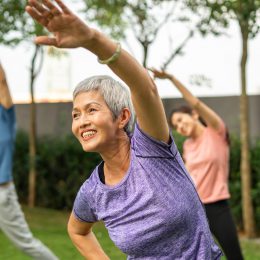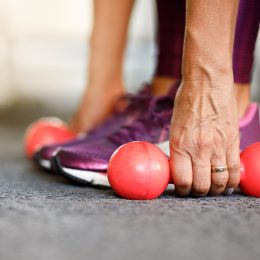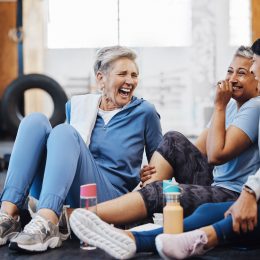6 Best Balance Exercises for Seniors to Improve Stability
Experts share how balance training helps you prevent falls and stay strong on your feet—for life.

When we’re young, we take staying upright for granted. We don’t really worry about doing exercises to improve balance. It might not even cross our minds that falling is a risk.
But over the years, things change. The vestibular system, which is the body’s sensory system that maintains balance, weakens with age. The body’s ability to detect gravity, identify exact body positioning at any moment, and promote balance and stability become less effective, says Caroline DeGroot, M.P.T., a physical therapist at Illinois Bone and Joint Institute in Bannockburn, Illinois.
On their own, these declines can make you feel undsteady and increase your risk of falling, but they often occur alongside losses in muscle strength and mobility, says Barbara Bergin, M.D., an orthopedic surgeon in Austin. She adds that type 2 diabetes, which affects about 25 percent of older adults, is one of the most common causes of peripheral neuropathy, or nerve damage that can result in numbness in the hands, feet, and other parts of the body.
High blood pressure, a condition that affects more than 63% of adults over the age of 60, can also throw you off balance. People with hypertension tend to react slower and have more trouble staying steady on their feet compared to people with normal blood pressure, according to research published in the Brazilian Journal of Physical Therapy.
Put all of that together, and it’s easy to see why falls are the number-one cause of injuries and death from injuries among older Americans.
In fact, according to a report from the Centers for Disease Control and Prevention, an older adult falls every single second of each day in the United States.
It’s never too early to start thinking about improving your balance and preventing falls. Below, DeGroot shares six of her favorite balance exercises. Perform these bodyweight moves as often as possible: when you’re standing at the kitchen counter or waiting in line while running errands.
Already had a spill? Start by telling your doctor and asking these important questions to recover from a fall injury.
Half of older adults who fall don’t tell their doctor—which means injuries can go untreated and a balance problem could get worse.
Follow your doctor’s instructions for any physical activity or physical therapy, and ask how you can exercise safely for better balance.
Add SilverSneakers to your wellness routine! Classes and events are happening right now at participating gyms, online through SilverSneakers LIVE, and at community centers near you. Activate your free online account to get started.
1. Foot Taps
This exercise strengthens the core muscles that help stabilize your spine.
How to do it:
- Stand tall with your feet hip-width apart in front of a step (the bottom step of a staircase will work) or low piece of furniture.
- If needed, hold on to the wall or a sturdy piece of furniture for balance. As you get stronger, perform the move without holding on to anything.
- From here, slowly raise one foot to tap the step in front of you, and then slowly return it to the floor.
- Perform 15 to 20 taps, then repeat on the opposite leg.
Recommended FREE SilverSneakers On-Demand Workout: Balance Exercises for Seniors: SilverSneakers Stability ‘E’ with Andi
2. Head Rotations
This exercise increases the mobility in your neck, which in turn helps with good posture and balance.
How to do it:
- Stand tall with your feet hip-width apart.
- If needed, hold on to the wall or a sturdy piece of furniture for balance. As you get stronger, perform the move without holding on to anything.
- From here, slowly move your head from side to side then up and down while keeping your body as still as possible.
- Do this for 30 seconds, and repeat. If you get dizzy, pause and move your head more slowly.
- If you’re still dizzy, stop.
3. Standing Marches
This is a core-strengthening exercise that helps shore up the muscles that support your spine.
How to do it:
- Stand tall with your feet hip-width apart.
- If needed, hold on to the wall or a sturdy piece of furniture for balance. As you get stronger, perform the move without holding on to anything.
- From here, lift one knee until your thigh is parallel to the floor (or as close to parallel as you can go) while keep your torso straight and avoiding any leaning.
- Pause, then slowly return your foot to the floor.
- Perform 20 marches, alternating between legs with each march.
4. Sit-to-Stands
This exercise not only provides strength training for your core muscles, but it is also a good alternative to squats if you have knee problems.
Subscribe to our newsletter
It's quick and easy. You could be one of the 13 million people who are eligible.
Already a member? Click to discover our 15,000+ participating locations.
Follow Us
How to do it:
- Stand tall with your back facing a sturdy chair and your feet hip-width apart.
- If needed, hold on to the wall or a sturdy piece of furniture for balance. As you get stronger, perform the move without holding on to anything.
- From here, sit back and slowly lower your hips on to the chair as gently as possible.
- Pause, and without swinging your torso, push through your heels to stand up.
- Perform 10 repetitions.
Love these exercises and want more? SilverSneakers Classic is a fun class for all fitness levels that includes fall prevention drills and exercises to improve strength and endurance. View the SilverSneakers LIVE schedule here.
5. Single-Leg Stands
This is a good balance exercise to try anytime of the day, such as when you are waiting for your coffee to brew.
How to do it:
- Stand tall with your feet hip-width apart.
- If needed, hold on to the wall or a sturdy piece of furniture for balance. As you get stronger, perform the move without holding on to anything.
- From here, lift one foot an inch off the floor while keeping your torso straight and without leaning toward your planted foot.
- Hold for 10 to 15 seconds, then slowly return your foot to the floor.
- Repeat on the opposite leg.
- Perform five stands on each leg.
6. Over-the-Shoulder Walks
This exercise challenges your brain and your body to work together to stay upright while doing two different tasks at the same time.
How to do it:
- Stand tall with your feet hip-width apart at one end of a hallway or room.
- If needed, hold on to the wall for balance. As you get stronger, perform the move without holding on to anything.
- From here, look behind you over one shoulder.
- Maintaining this gaze, take four to five steps forward.
- Then, look over your other shoulder, and take four to five more steps forward.
- Perform five repetitions on each side.
Recommended reading: Take the 7-Day Better Balance Challenge with SilverSneakers!
Activate Your FREE SilverSneakers Online Account
Get hundreds of free SilverSneakers On-Demand videos and stay in touch with us by creating your free online account. You don’t have to be a SilverSneakers member to get on-demand workout videos, health and fitness tips from SilverSneakers, and more.
SilverSneakers members can go to thousands of nationwide gyms and fitness locations, plus take SilverSneakers LIVE online classes led by specially trained instructors and designed for all fitness levels and abilities – at no additional cost. If you have a Medicare Advantage plan, it may include SilverSneakers. Check your eligibility here.
Already a member? Get your SilverSneakers member ID, search for locations near you, and all the health and wellness resources you need by logging in to your online member account here.





